This post may contain affiliate links. Please see our disclosure policy.
White bean soup and butternut squash are paired perfectly in this simple soup canning recipe.
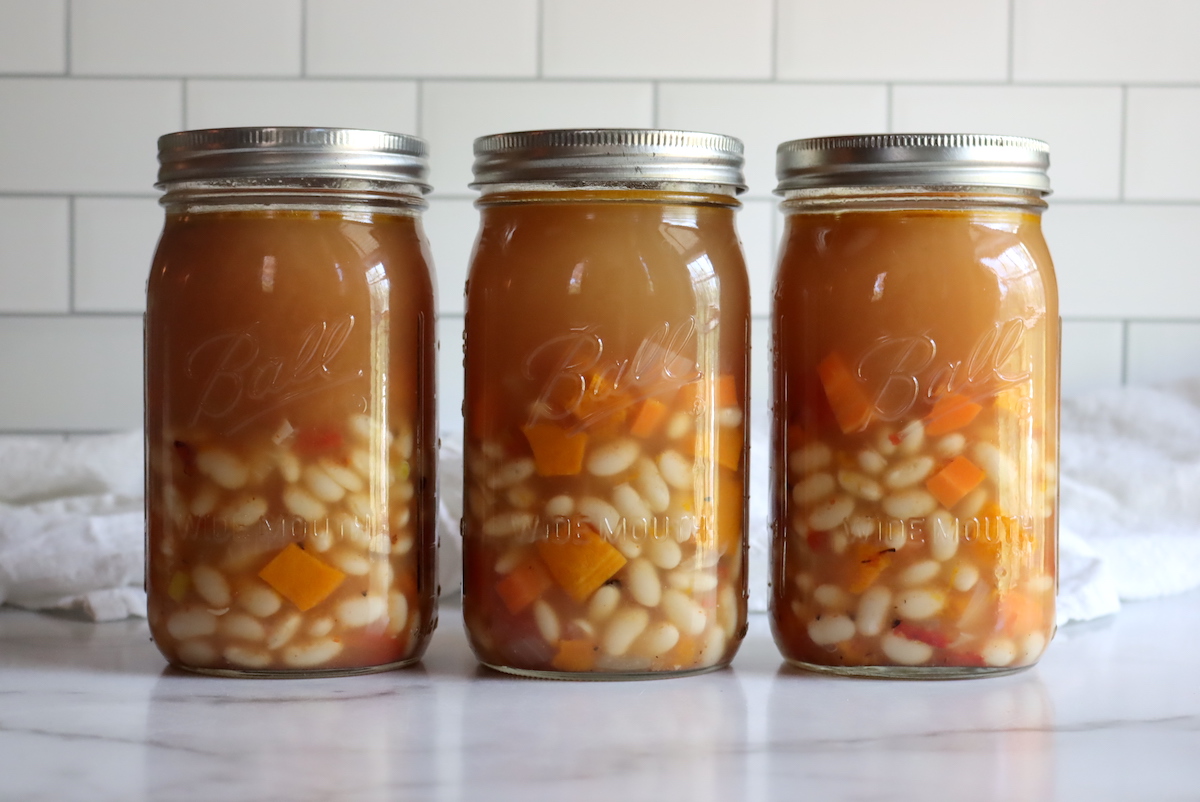
Soup is the ultimate comfort food, and when it comes to hearty and nourishing soups, Butternut Squash and White Bean Soup is a must-try.
The creamy white beans pair beautifully with the subtly sweet squash in this vegetarian soup canning recipe, and the tomatoes add just enough acidity and balance to bring it all together.
This simple soup canning recipe is like canning butternut squash soup, but heartier with the addition of beans. And it leans into comforting old world flavors. (Though if you’re more into Asian spice, Ball Canning also has a Thai Spiced Butternut Soup Canning Recipe.)
So many choices, but this version is my favorite!
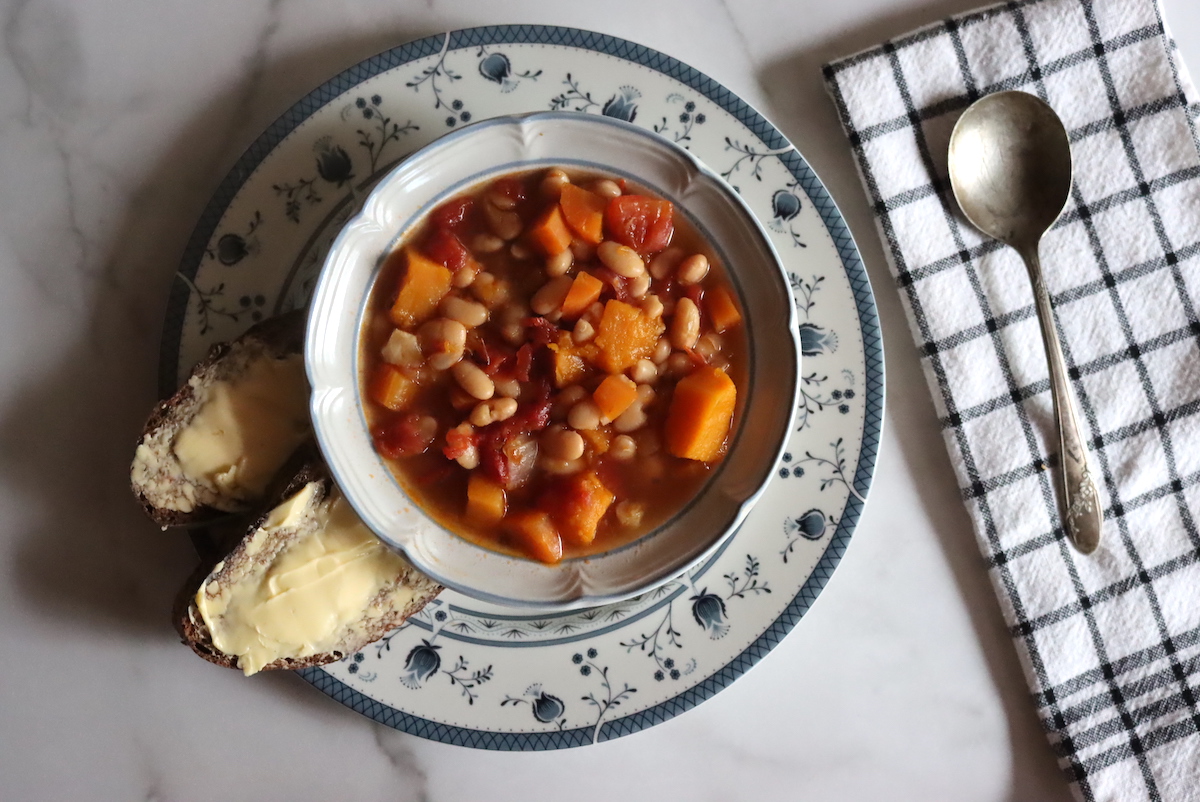
Ingredients for Butternut Squash and White Bean Soup
This recipe for canning taco soup is adapted from Pressure Canning for Beginners and Beyond by Angi Schneider, which happens to be my very favorite pressure canning book. Angi’s recipes are always spot on, and this recipe is perfect. The sweetness of the butternut is balanced by the savory white beans, and a rich chicken stock is just what it needs to come together.
She’s added a bit of cider vinegar to the recipe, and that’s for flavor, not preservation. A bit of acidity really makes the flavors pop, but it’s not strictly required for canning safety.
The ingredients for canning butternut squash and white bean soup are quite simple. To make a canner batch of eight pints or four quarts, you’ll need the following:
- 2 lbs (907 g) peeled, cubed, and deseeded butternut squash (cut into 1-inch or 2.5 cm cubes)
- ¾ lbs (339 g) dried cannellini beans, presoaked
- 2 tbsp (30 ml) olive oil
- 2 cups (320 g) chopped yellow onions
- 1 cup (128 grams) diced carrots
- 6 cups (1.4 L) chicken or vegetable broth
- 5 cups (1.3 kg) peeled and crushed tomatoes
- 4 cloves garlic, minced
- 1 tbsp (15 ml) apple cider vinegar
- 1 tbsp (18 g) non iodized salt
- 1 tsp dried thyme
All in all, you will need about 3 lbs (1.4 kg) of whole butternut squash and ¾ lb (340 g) of unprepared onions. You can substitute any other type of onion for this recipe, but yellow and white tend to offer the mildest flavor for this dish. Similarly, you can use another type of winter squash (such as acorn or hubbard squash) as a modification for this recipe.
You will need a total of 3 ⅓ lbs (1.6 kg) total of unprepared tomatoes. You can also substitute canned tomatoes if you choose. This recipe can be made without tomatoes, and in that case, you’d just add more chicken or vegetable broth to fill the jars to 1” headspace.
Finally, don’t forget to soak the beans before starting this recipe, but it is helpful. If you forgot to soak them overnight, you can bring them to a boil for 2 minutes, then turn off the heat and allow them to soak for an hour in the hot water before draining and proceeding with the recipe (known as the quick soak method).
Use the overnight or quick soak method, but make sure you do this ahead of time so you don’t delay your project.
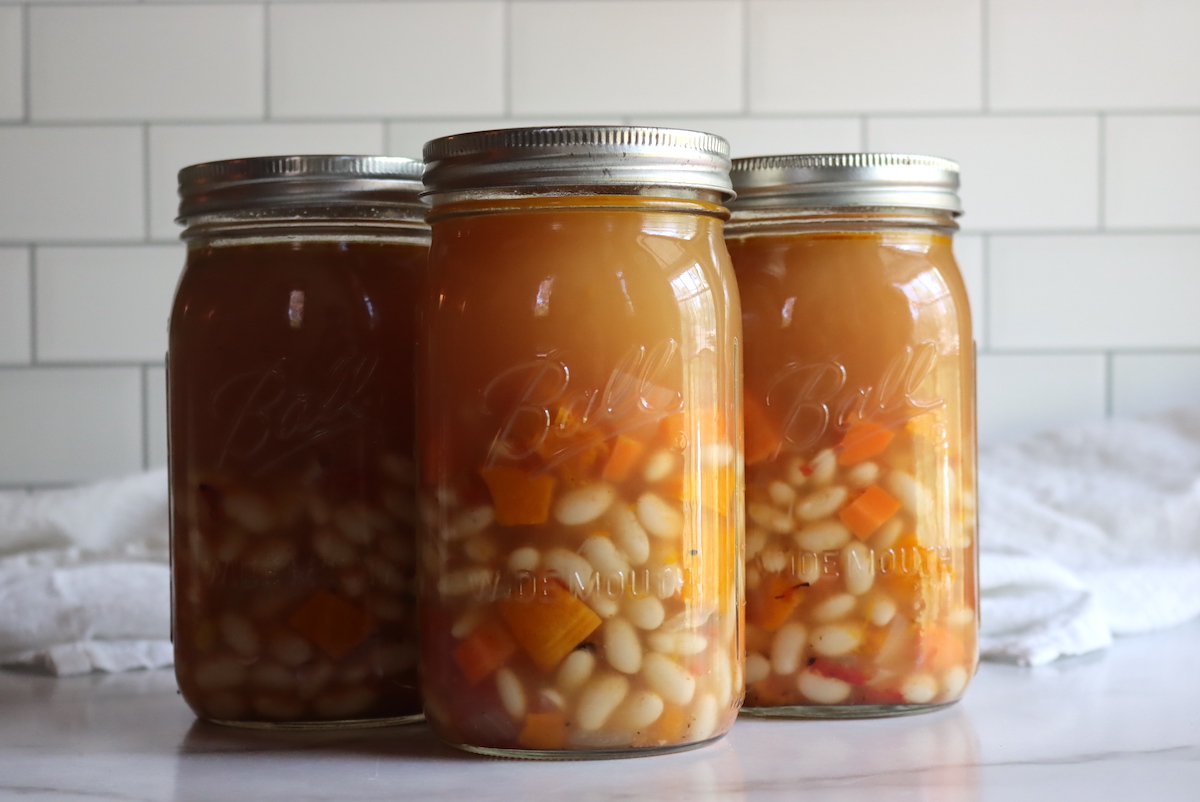
Canning Butternut Squash and White Bean Soup
To get started, prepare the pressure canner, jars, and lids. You will need eight 1-pint jars or four 1-quart jars. Fill your canner with a few inches (about 8 cm) of water, depending on the instructions from your manufacturer, and place the canner on the stovetop over low heat with the jars inside to keep them hot.
Because this is a hot-pack recipe, the water needs to be heated to about 180 degrees Fahrenheit (82 degrees Celsius).
Put the oven on the broil setting, then coat the butternut squash cubes in oil and spread them on a baking sheet. Broil the cubes in the oven until they are fully browned. This will take around three to five minutes, but be careful not to burn them. They might not all be equally browned, but that’s okay – just make sure you don’t fully cook the squash or it will become mushy.
If you’d prefer to skip this step, that’s fine. However, the roasting process does lend itself to a more flavorful soup.
Drain the water from the beans you soaked. Place them in a large stockpot and cover them with fresh water, then bring the beans to a boil. Remove from the heat and drain the water.
Put the beans back in the stockpot on the stove. Add the roasted butternut squash cubes, along with the onions, carrots, broth, tomatoes, vinegar, spices, and garlic. Bring the mixture to a boil over high heat, then reduce it to a gentler boil for about five minutes.
At this point, the squash and beans won’t be fully cooked – that’s ok. They’ll cook in the jars. Don’t keep cooking them on the stovetop or, again, they may become too soft after processing.
Take the stockpot off the heat. Then, ladle the soup into jars, putting the solids in evenly and using a bubble removal tool to get rid of any bubbles. Check for headspace, aiming for about 1 inch (2.5 cm) of headspace.
If you find yourself short on liquid, feel free to add boiling water or hot chicken or vegetable broth. Before putting the lids on the jars, wipe the rims with a clean, damp cloth. Place the bands and lids on the jars and load them into the pressure canner.
Process the jars at 10 lbs of pressure for 75 minutes (69 kPa) for 1-pint jars and 90 minutes for 1 quart jars. Adjust for latitude or for your manufacturer’s instructions if necessary.
Altitude Adjustments for Canning Soup
With pressure canning, the processing times stay the same at higher altitudes, but the pressures change. Here are the altitude adjustments for pressure canning soup:
For dial gauge pressure canners:
- 0 to 2,000 feet in elevation – 11 lbs pressure
- 2,001 to 4,000 feet in elevation – 12 lbs pressure
- 4,001 to 6,000 feet in elevation – 13 lbs pressure
- 6,001 to 8,000 feet in elevation – 14 lbs pressure
For weighted gauge pressure canners:
- 0 to 1,000 feet in elevation – 10 lbs pressure
- Above 1,000 feet – 15 lbs pressure
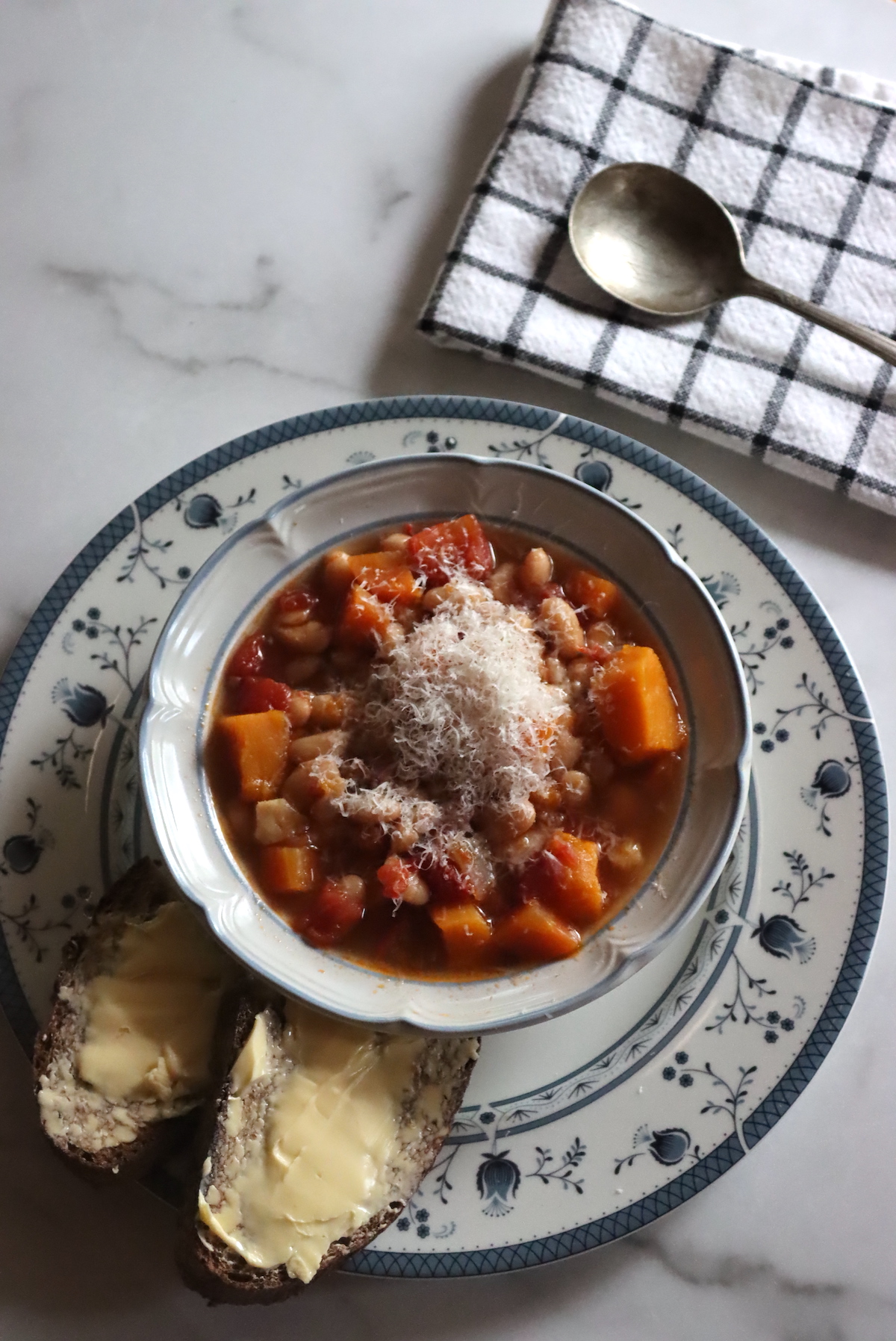
Serving Butternut Squash and White Bean Soup
When it comes to serving Butternut Squash and White Bean Soup, the options are endless. This soup is a meal in itself and can be enjoyed as is, or you can pair it with some crusty bread, crackers, or a fresh salad.
This soup is also perfect for those cold winter nights when all you want is a warm and comforting bowl of soup. You can reheat the soup in the microwave or on the stovetop, and you’ll have a wholesome meal ready in minutes.
You may want to add 1⁄4 cup (60 ml) heavy cream as well as some chopped green onions or chives when you serve this recipe. Both add a wonderful depth and complexity of flavor!
If you don’t have cream, you can eat it as is, or top it with a bit of freshly grated cheese (as I prefer).
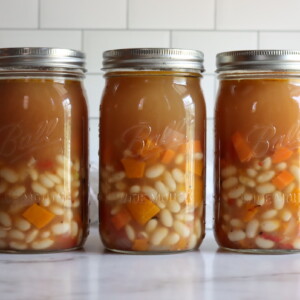
Canning White bean Soup with Butternut Squash
Ingredients
- 2 lbs butternut squash, peeled, cubed, and de-seeded, cut into 1-inch or 2.5 cm cubes
- ¾ lbs dried cannellini beans, presoaked
- 2 tbsp olive oil
- 2 cups onions, diced
- 1 cup carrots, peeled and diced
- 6 cups broth, chicken or vegetable
- 5 cups tomatoes, peeled and crushed, fresh or canned
- 4 cloves garlic, minced
- 1 tbsp apple cider vinegar
- 1 tbsp canning salt
- 1 tsp dried thyme
Instructions
- Prepare the pressure canner, jars, and lids. You will need eight 1-pint jars or four 1-quart jars. Fill your canner with a few inches (about 8 cm) of water, depending on the instructions from your manufacturer, and place the canner on the stovetop over low heat with the jars inside to keep them hot. Heat the water to about 180 degrees Fahrenheit (82 degrees Celsius).
- Put the oven on the broil setting, then coat the butternut squash cubes in oil and spread them on a baking sheet.
- Broil the cubes in the oven until they are fully browned. This will take around five minutes.
- Drain the water from the beans you soaked. Place them in a large stockpot and cover them with fresh water, then bring the beans to a boil.
- Remove from the heat and drain the water.
- Put the beans back in the stockpot on the stove. Add the roasted butternut squash cubes, along with the onions, carrots, broth, tomatoes, vinegar, spices, and garlic.
- Bring the mixture to a boil over high heat, then reduce it to a gentler boil for about five minutes.
- Take the stockpot off the heat. Then, ladle the soup into jars, putting the solids in evenly and using a bubble removal tool to get rid of any bubbles.
- Check for headspace, aiming for about 1 inch (2.5 cm) of headspace.
- If you find yourself short on liquid, add boiling water or hot chicken or vegetable broth.
- Before putting the lids on the jars, wipe the rims with a clean, damp cloth. Place the bands and lids on the jars and load them into the pressure canner.
- Process the jars at 10 lbs of pressure for 75 minutes (69 kPa) for 1-pint jars and 90 minutes for 1 quart jars. Adjust for altitude or for your manufacturer’s instructions if necessary.
- When the time has elapsed, turn the heat off and allow the canner to depressurize on its own. Then, remove the jars and allow them to cool for 12 hours before storing.
Notes
- ¼ cup (60 ml) heavy cream
- Chopped green onions or chives
Altitude Adjustments for Canning Soup
With pressure canning, the processing times stay the same at higher altitudes, but the pressures change. Here are the altitude adjustments for pressure canning soup:For dial gauge pressure canners:
- 0 to 2,000 feet in elevation – 11 lbs pressure
- 2,001 to 4,000 feet in elevation – 12 lbs pressure
- 4,001 to 6,000 feet in elevation – 13 lbs pressure
- 6,001 to 8,000 feet in elevation – 14 lbs pressure
For weighted gauge pressure canners:
- 0 to 1,000 feet in elevation – 10 lbs pressure
- Above 1,000 feet – 15 lbs pressure
Nutrition
Nutrition information is automatically calculated, so should only be used as an approximation.
Soup Canning Recipes
There are so many different soup canning recipes out there, try these for your pantry:
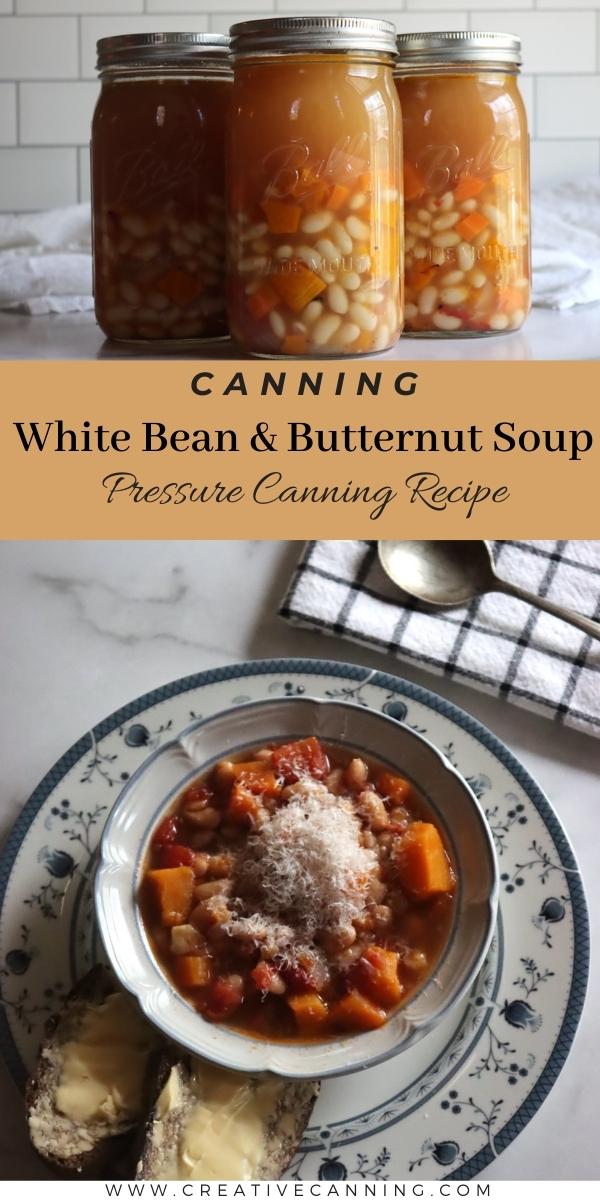
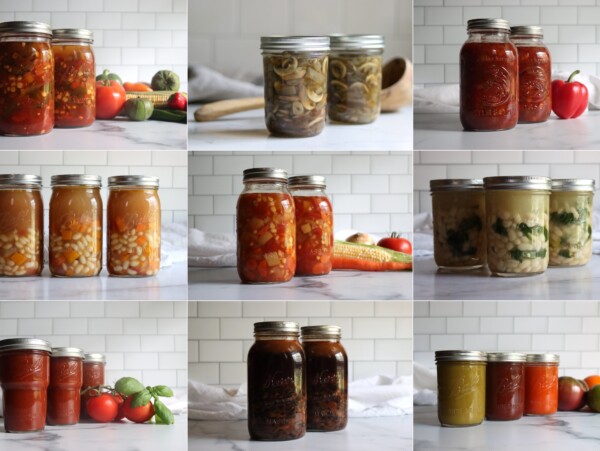
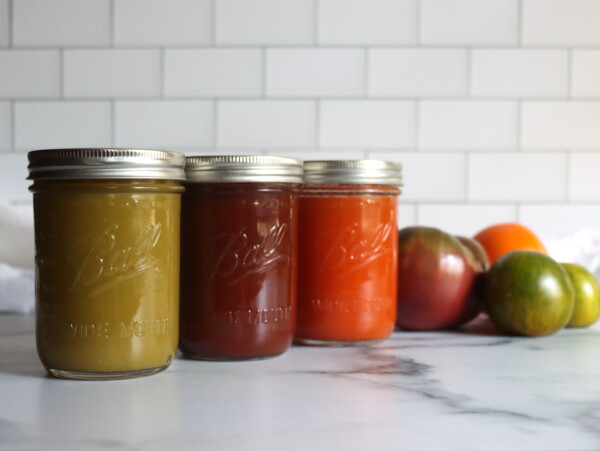
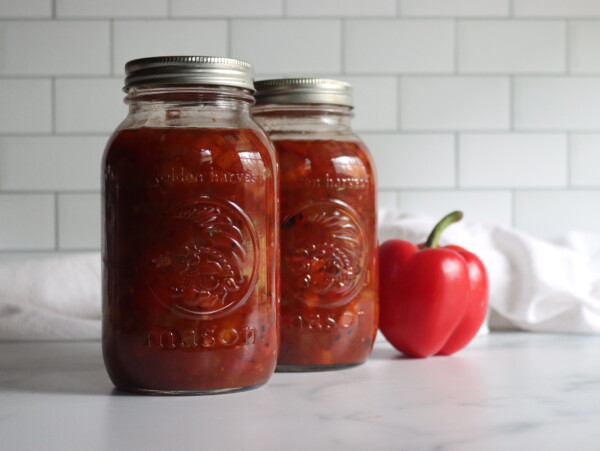

Hi Ashley!
I can’t have tomatoes- what other veg could I use instead? Equal amount of kale?
This recipe follows the “choice” soup protocol for canning. You can read more about that here and what changes you can make: https://creativecanning.com/choice-soup-canning-recipe/
In short, yes, you can substitute kale for the tomatoes (or just skip the tomatoes), just make sure you don’t fill the jars more than half way with solids.
This is so good! I just canned it this fall.
When I served the first jar, I cooked up ground chicken with sausage seasonings, added a package of kale and a quart of broth. Once those were cooked I added the jar of soup to the pot. It made a nice hearty meal.
That sounds amazing!
New favorite comfort soup! I find that the squash gets too soft, so I put the whole thing in the blender and I now have my favorite mug of soup! Thank you for the inspiration!
Wonderful, so glad you enjoyed it! (I guess it depends on your squash, some stay firmer than others.)